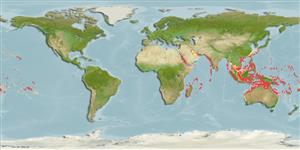>
Eupercaria/misc (Various families in series Eupercaria) >
Labridae (Wrasses) > Pseudodacinae
Etymology: Pseudodax: Greek,pseudes = false + Greek, odax, = with the teeth (Ref. 45335).
More on author: Valenciennes.
Environment: milieu / climate zone / depth range / distribution range
Ecologia
marinhas associadas(os) a recifes; intervalo de profundidade 3 - 60 m (Ref. 9823), usually 4 - 40 m (Ref. 27115). Tropical; 24°C - 28°C (Ref. 27115); 32°N - 24°S
Indo-Pacific: Red Sea to South Africa (Ref. 35918) and to the Society, Marquesan and Tuamoto islands, north to southern Japan.
Tamanho / Peso / Idade
Maturity: Lm ? range ? - ? cm
Max length : 30.0 cm TL macho/indeterminado; (Ref. 30573)
Descrição breve
Chaves de identificação | Morfologia | Morfometria
Espinhos dorsais (total) : 11; Raios dorsais moles (total) : 12; Espinhos anais: 3; Raios anais moles: 14.
Inhabits clear channels and seaward reefs (Ref. 9710). Juveniles are commonly found along drop-offs below 18 m (Ref. 9710). Adults usually found near caves while juveniles frequently live inside them. Adults are solitary and feed on algae and small invertebrates. Juveniles have been observed 'cleaning' other fishes. Because of its dentition, it is regarded as a close relative to the parrotfishes (Scaridae), although it behaves like the species of Anampses.
Life cycle and mating behavior
Maturities | Reprodução | Spawnings | Egg(s) | Fecundities | Larvas
Oviparous, distinct pairing during breeding (Ref. 205).
Westneat, M.W., 2001. Labridae. Wrasses, hogfishes, razorfishes, corises, tuskfishes. p. 3381-3467. In K.E. Carpenter and V. Niem (eds.) FAO species identification guide for fishery purposes. The living marine resources of the Western Central Pacific. Vol. 6. Bony fishes part 4 (Labridae to Latimeriidae), estuarine crocodiles. FAO, Rome. (Ref. 9823)
Categoria na Lista Vermelha da IUCN (Ref. 130435)
Ameaça para o homem
Harmless
Utilização humana
Pescarias: pouco comercial; Aquário: Espécies comerciais
Ferramentas
Relatórios especiais
Descarregue XML
Fontes da internet
Estimates based on models
Preferred temperature (Ref.
123201): 25.5 - 29, mean 28 °C (based on 1384 cells).
Phylogenetic diversity index (Ref.
82804): PD
50 = 1.0000 [Uniqueness, from 0.5 = low to 2.0 = high].
Bayesian length-weight: a=0.01122 (0.00514 - 0.02450), b=3.04 (2.87 - 3.21), in cm total length, based on all LWR estimates for this body shape (Ref.
93245).
Nível Trófico (Ref.
69278): 2.8 ±0.26 se; based on food items.
Resiliência (Ref.
120179): Médio, tempo mínimo de duplicação da população 1,4 - 4,4 anos (Preliminary K or Fecundity.).
Fishing Vulnerability (Ref.
59153): Low vulnerability (20 of 100).
Nutrients (Ref.
124155): Calcium = 56.2 [32.6, 88.7] mg/100g; Iron = 0.621 [0.367, 1.129] mg/100g; Protein = 18.2 [15.4, 20.4] %; Omega3 = 0.136 [0.091, 0.207] g/100g; Selenium = 32.2 [20.4, 54.9] μg/100g; VitaminA = 98.8 [30.2, 359.3] μg/100g; Zinc = 1.6 [1.2, 2.6] mg/100g (wet weight);
